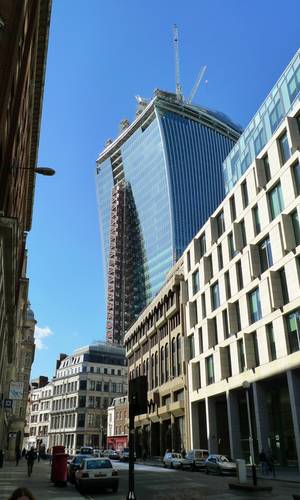You may have heard this week about a new building at 20 Fenchurch St, in the  City of London. The 37-storey skyscraper, which has already been dubbed the 'Walkie-talkie' due to its unusual shape, has been blamed for cooking a number of vehicles parked nearby. Some suggest that this might be due to the novel shape of the building, which causes it to act as a parabolic reflector, targeting sun's rays. Here's the quick fire science behind parabolic reflectors and their uses.
City of London. The 37-storey skyscraper, which has already been dubbed the 'Walkie-talkie' due to its unusual shape, has been blamed for cooking a number of vehicles parked nearby. Some suggest that this might be due to the novel shape of the building, which causes it to act as a parabolic reflector, targeting sun's rays. Here's the quick fire science behind parabolic reflectors and their uses.
1. A parabolic reflector is a curved, mirrored surface which can be used to collect and focus energy in the electromagnetic spectrum
2. Reflectors have a paraboloid shape, as seen in satellite dishes.
3. When light shines in to a parabolic reflector, the rays of light are reflected so that they all converge at a single focal point.
4. If the incoming light to a reflector is sufficient, the temperature at the focal point can be as high as 3000°c, meaning that items placed at the focus can burn.
5. Alternatively, if a light is placed at the focal point of a parabolic reflector, the rays will be reflected back to give parallel beams of light.
6. For a parabolic reflector to be as effective as possible, it must have an extremely precise construction to prevent the incoming and reflected rays of light from cancelling each other out.
7. For a reflector of visible light, this means that construction must be correct to within 20nm. A greater degree of variation is acceptable for reflectors of larger electromagnetic waves, such as micro and radiowaves.
8. One of the earliest reports of the use of a parabolic reflector is attributed to the Greek mathematician Archimedes in the 3rd century BC. It is said that during the siege of Syracuse, Archimedes used a parabolic arrangement of mirrors to set fire to enemy Roman ships as they approached the city, although it is unclear how effective this actually was.
9. It is thought that the 'Walkie-Talkie' skyscraper, which has a 160m tall curved glass structure, is acting as a parabolic reflector, thus causing it to melt cars and other objects which happen to be placed at its focal point.
10. However, the skyscraper is by no means a perfect parabolic reflector, and has thus far only been estimated to reach temperatures of around 100 degrees centigrade at its approximate focal point, rather than the thousands of degrees centigrade which could be reached with a purpose-built reflector of this size.
11. Parabolic reflectors have a variety of other more common uses, such as in radio telescopes and car headlights. The Olympic torch at Olympia is also lit using a parabolic reflector.
- Previous Stress and cancer link?
- Next Quick Fire Science: Nuclear Power









Comments
Add a comment